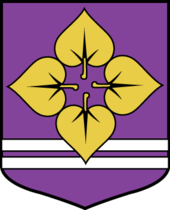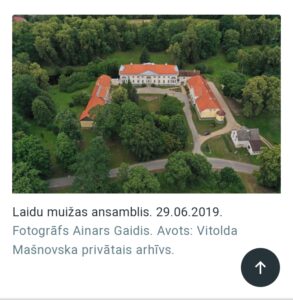Laidu (Laiden) muižas pirmsākumi meklējami 16. gadsimta un 17. gadsimta mijā. Muižas komplekss veidojās pie tagadējās pārvaldnieka mājas, kas ir vecākā ēka kompleksā. No 1800. līdz 1810. gadam Manteifels savai meitai cēla pašreizējo muižas pili ar saimniecības ēkām klasicisma stilā. Apbūve veidota simetriski ap pagalmu. Pilij abās pusēs, viena otrai pretī klēts-ratnīca un pārvaldnieka māja, kuras ar pili savieno vārti vienotā būvapjomā.
Muiža piederēja Kurzemes bīskapa zemēm un tikai 1562. gadā bīskaps Magnuss to izlēņoja kambarkungam E. fon Ganckovam. Pēc tam kādu laiku tā piederēja Manteifeļa-Cēges dzimtai, bet no 17. gadsimta vidus līdz 18. gadsimta vidum – fon Brinkeniem. 1720. gadā muižu ieguva Mirbahu dzimta. No 1750. gada tā bija Taubes īpašumā. 1797. gadā muižu ieguva Liepājas tirgotājs H. F. Bordēls, kurš nopirka arī muižnieka titulu un kļuva par fon Bordēliusu. No viņa 1808. gadā fon Manteifels nopirka muižu savai meitai Johannai fon Lambsdorfai, un turpmāk tā palika viņu īpašumā. Otrā pasaules kara gados te bijis vācu armijas hospitālis. Kopš 1921. gada muižā ierīkota skola, kura tika likvidēta 2022.gadā. http://laidupsk.ucoz.lv
Telpas Laidu muižā, ko līdz šim izmantoja Laidu pamatskola, nodeva bezatlīdzības lietošanā biedrībai “Give and Get”, kam ir sabiedriskā labuma organizācijas statuss, biedrības darbības mērķu nodrošināšanai – tā 30. jūnija domes sēdē lēma deputāti.
Biedrība “Give and Get” vēlas telpas Laidu muižā izmantot Laidu kultūras un mākslas centra izveidei.
Laidu muižas ansamblis ir valsts nozīmes arhitektūras piemineklis.
https://kuldiga.lv/kuldigas-novads/aktualitates-pagastos/6849-nodos-lietosana-laidu-muizu-telpas
[ENG]The origins of Laiden Manor can be traced back to the 16th and 17th centuries. The manor complex was formed near the current manager’s house, which is the oldest building in the complex. From 1800 to 1810, Manteifel gave his daughter the current manor house with outbuildings in the Classicist style. The building is built symmetrically around the yard. On both sides of the castle, opposite each other, a barn-carriage and a manager’s house, which are connected to the castle by a gate in a single construction volume
The manor belonged to the lands of the bishop of Kurzeme and only in 1562 did Bishop Magnus rent it to the chamberlain E. von Ganckov. It then belonged to the Manteifel-Cege family for some time, and from von Brinken to the mid-17th to mid-18th centuries. In 1720 the manor was acquired by the Mirbach family. From 1750 it was owned by Taube. In 179, the manor was acquired by H. F. Bordel, a merchant from Liepaja, who also held the title of nobleman7 and a merchant as von Bordelius. From him, in 1808, von Manteifel bought a manor for his daughter, Johann von Lambsdorf, and it remained their property. During the Second World War, there was a German army hospital here. A school has been established in the manor since 1921, which was liquidated in 2022.
The premises in the Laidu manor, which until now were used by the Laidu elementary school,
were given to the association “Give and Get” for free use, which has the status of a public benefit organization, for free use, to ensure the objectives of the association’s activities – this was decided by the deputies at the council meeting on June 30. The association “Give and Get” wants to use the premises in the Laidu manor for the creation of the Laidu Culture and Art Center.
Laidu manor ensemble is an architectural monument of national importance.
https://kuldiga.lv/kuldigas-novads/aktualitates-pagastos/6849-nodos-lietosana-laidu-muizu-telpas

